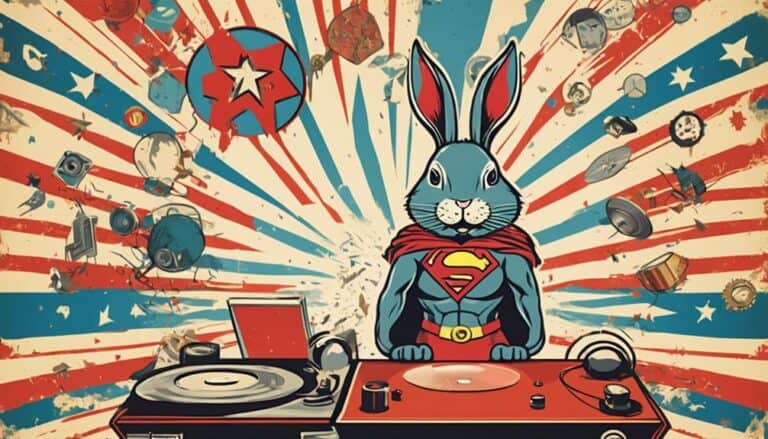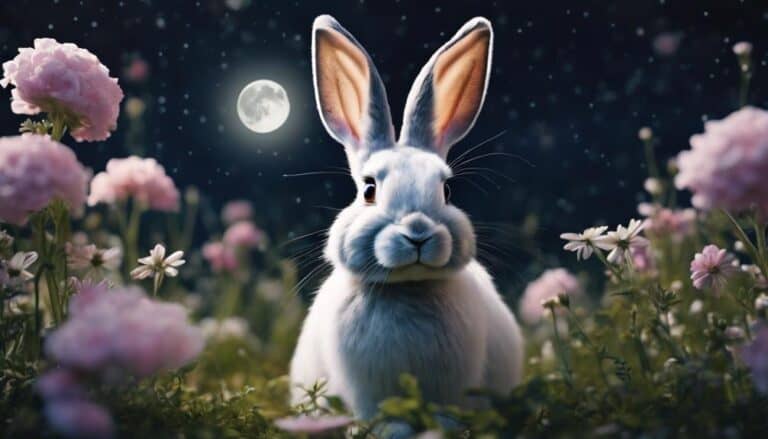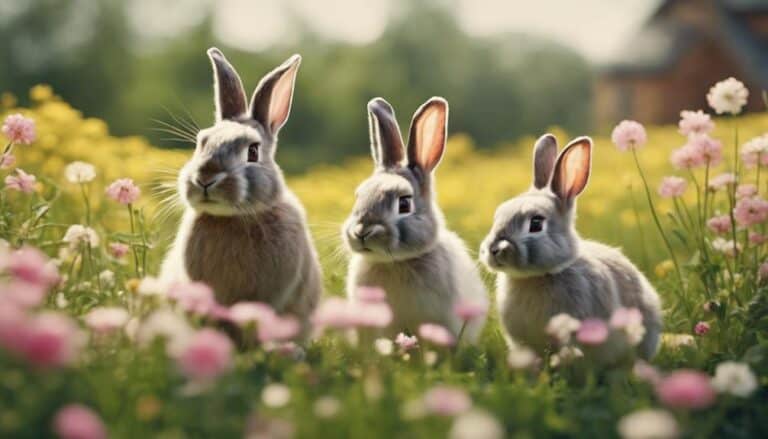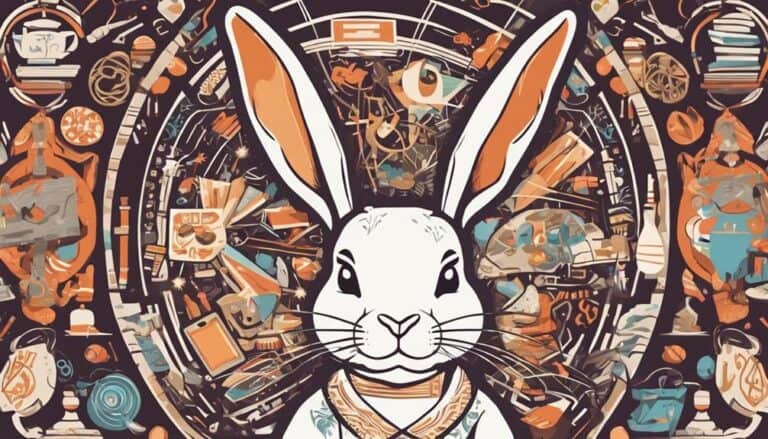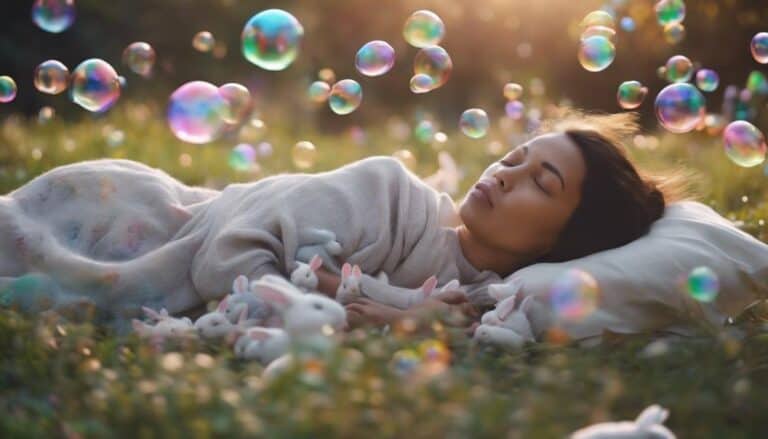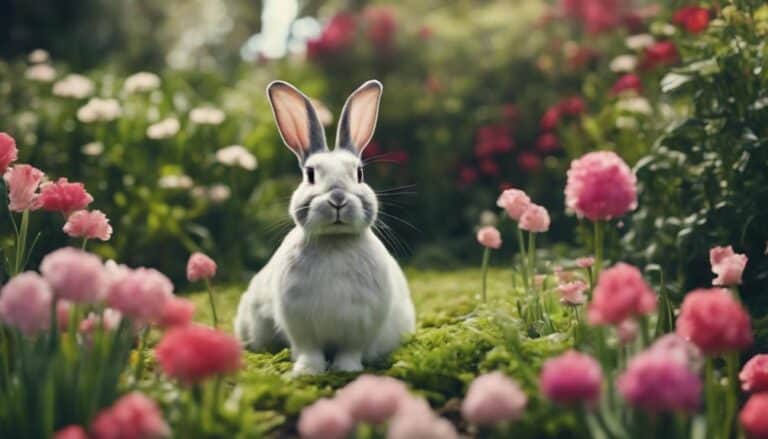In the world of pop culture, bunnies may seem like fluffy and innocent creatures, but their symbolism runs deeper than meets the eye.
From their association with luck and rebirth to their darker representations in horror, bunnies captivate artists and audiences alike with their multifaceted meanings.
Whether you are a fan of animated classics or psychological thrillers, the allure of bunny symbolism in pop culture raises intriguing questions about the human psyche and the stories we tell.
Contents
Key Takeaways
- Bunny symbolism spans ancient cultures, horror genres, Easter traditions, and modern media.
- Rabbits represent innocence, darkness, agility, and renewal in diverse pop culture expressions.
- Bunnies captivate audiences with their versatile symbolism in films, folklore, and fashion.
- Pop culture's embrace of bunny symbolism reflects a universal fascination with luck, agility, and new beginnings.
Origins of Bunny Symbolism
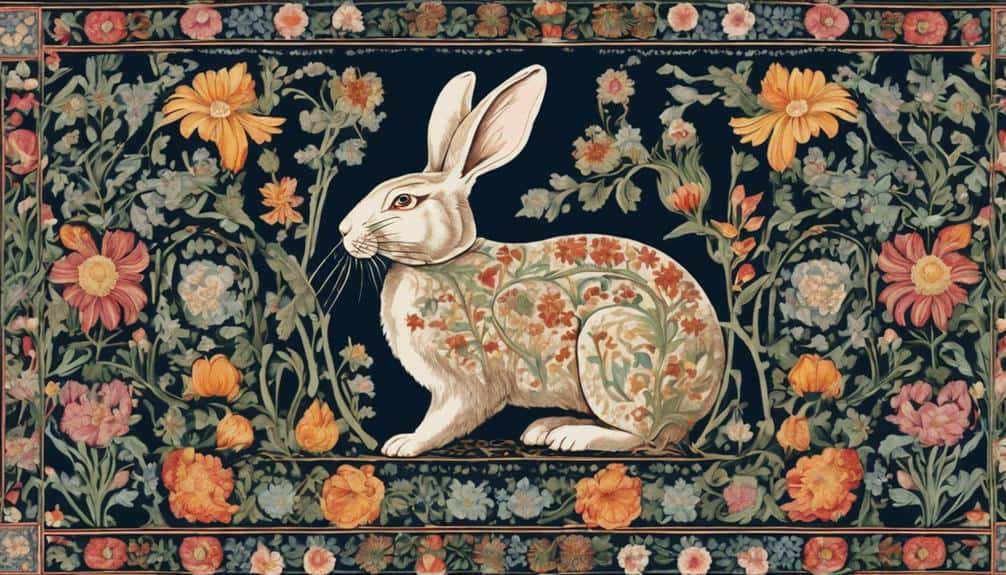
Originating in ancient cultures such as Egypt, Native America, China, Celtic, and Navajo tribes, rabbit symbolism holds profound significance in various aspects of life and nature. The rabbit, a creature known for its agility and reproduction abilities, is revered for different qualities across these diverse cultures.
In Chinese culture, rabbits symbolize longevity, fertility, and good fortune, embodying the hopes for a prosperous and enduring life. On the other hand, the Navajo tribe associates rabbits with rain and abundance, reflecting their deep connection to nature and the land.
Additionally, rabbits symbolize luck, fertility, abundance, and new beginnings in many other cultures, signifying positive attributes that are universally valued. This rich tapestry of meanings attributed to rabbits showcases the reverence and importance these animals hold in the collective consciousness of humanity, transcending geographical boundaries and time periods.
Bunny Symbolism in Horror Movies
Horror movies often use bunnies to symbolize innocence and happiness, setting a stark contrast that heightens fear in viewers.
Films like 'Us' utilize creepy rabbit imagery to convey deeper meanings such as rebirth, duality, and underlying darkness within characters.
The presence of scary rabbits in horror flicks serves to evoke a sense of unease and explore themes of facing one's inner demons and the darker aspects of humanity.
Horror Bunnies in Film
In various horror films, the portrayal of bunnies as symbols of innocence transforming into fear and darkness enhances the overall chilling atmosphere. Rabbits have been utilized in horror movies to symbolize the shift from purity to terror, creating an unsettling contrast that intensifies the sense of dread.
Examples such as the killer rabbit in 'Monty Python' and Frank the Rabbit in 'Donnie Darko' showcase how rabbits have historically been used to evoke fear and darkness in cinema. In films like 'Us,' rabbits represent themes of rebirth, duality, and the hidden darkness within individuals, adding layers of complexity to their symbolism.
Creepy Rabbit Imagery
With an eerie allure that transcends the screen, creepy rabbit imagery in horror movies captivates audiences through its unsettling symbolism and chilling undertones.
In films like 'Us,' rabbits symbolize rebirth, duality, and inherent darkness, intensifying fear by portraying innocence turning dark and scary.
Historical horror movies also feature menacing rabbits, delving into themes of violence and fear, using these creatures as a metaphor for confronting one's shadow self and inner darkness.
The influence of 'Alice's Adventures' is evident in how filmmakers like Jordan Peele use rabbit imagery to evoke fear and symbolism, drawing viewers into a world where the line between innocence and horror is blurred.
Bunny as Fear
Enthralling audiences with its unsettling symbolism and chilling undertones, the portrayal of creepy rabbit imagery in horror movies serves to intensify fear through the representation of innocence twisted into something dark and scary.
In the horror genre, there's a deep-seated fascination with rabbits as symbols of fear. Movies like 'Us' utilize rabbits to symbolize rebirth and duality, adding layers of complexity to the narrative.
Historical references such as Frank in 'Donnie Darko' and killer rabbits in 'Monty Python' have further cemented the association of rabbits with fear in popular culture.
The use of rabbits in horror films reflects themes of past sins and reckoning, creating a sense of unease and foreboding. Directors like Jordan Peele leverage the inherent fear of rabbits to evoke deeper meanings and psychological horror in their works.
The Easter Bunny in Popular Culture
Rooted in German folklore and symbolizing abundance and new beginnings, the Easter Bunny holds a significant place in popular culture. This beloved symbol of Easter has been embraced worldwide, embodying themes of fertility, prosperity, and the joy of spring.
Here are some ways the Easter Bunny has made its mark in popular culture:
- Easter Egg Hunts: The Easter Bunny is often associated with the tradition of hiding and hunting for colorful eggs, bringing delight to children and families during the holiday season.
- Commercialization: The Easter Bunny has been commercialized through various products like chocolates, candies, toys, and decorations, becoming a staple in Easter celebrations.
- Media Representation: The Easter Bunny has appeared in numerous films, TV shows, and books, captivating audiences with its enchanting and magical presence.
- Community Events: Many communities host Easter Bunny parades, where individuals dress up as the festive character, spreading cheer and joy.
- Symbol of Hope: The Easter Bunny serves as a symbol of hope, renewal, and the joys of life, reinforcing the spirit of the season in popular culture.
The White Rabbit in Alice in Wonderland
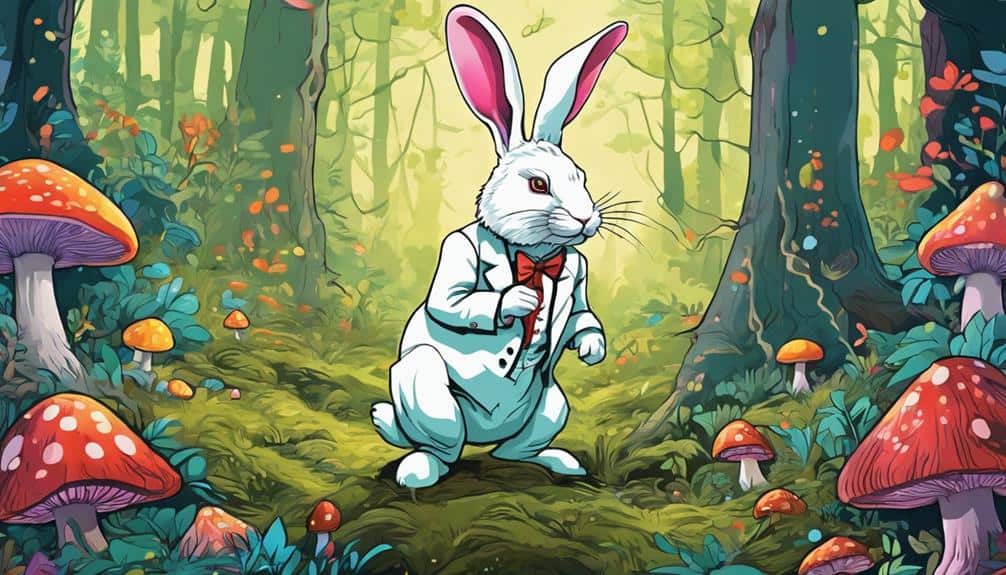
In Lewis Carroll's Alice in Wonderland, the White Rabbit serves as a symbolic figure guiding Alice through a whimsical journey. Its frantic behavior and fixation on time depict societal expectations and the fleeting nature of time.
Symbolism in Wonderland
Upon encountering the White Rabbit in Alice in Wonderland, readers are immediately drawn into a world of whimsy and intrigue as this iconic character leads Alice on a fantastical journey through Wonderland. The symbolism in Wonderland is rich and profound, with the White Rabbit playing a vital role in shaping the narrative. Here are some key points to contemplate:
- The White Rabbit symbolizes curiosity and adventure, setting the tone for Alice's exploration.
- Known for always being late, the White Rabbit adds an element of urgency and unpredictability to the story.
- The phrase 'going down the rabbit hole' has become synonymous with embarking on a surreal or bizarre journey.
- Through the White Rabbit, Lewis Carroll adds depth and complexity to the narrative, gripping readers with its enigmatic nature.
- This character's presence underscores the transformative and mind-bending experiences that await Alice in Wonderland.
White Rabbit's Influence
The White Rabbit's presence in Alice in Wonderland not only sets the stage for a whimsical adventure but also serves as a profound symbol of time, societal pressures, and the anxieties associated with them. The White Rabbit, with its iconic pocket watch and harried demeanor, represents the constant struggle against time and societal expectations. This character's fixation on punctuality mirrors the pressures individuals face to conform to rigid schedules and meet societal standards. In Chinese zodiac symbolism, rabbits are associated with sensitivity, creativity, and agility, traits that align with the White Rabbit's quick movements and alert nature. Through this lens, the White Rabbit becomes a multifaceted symbol, reflecting both universal anxieties about time and the individual's internal struggles with societal demands.
| Traits | Description |
|---|---|
| Sensitivity | The White Rabbit's awareness of time slipping away reflects a sensitivity to life's fleeting nature. |
| Innovation | Its role in a fantastical world showcases innovation in overcoming challenges and embracing whimsy. |
| Agility | The White Rabbit's quick movements symbolize the agility needed to adapt to changing circumstances. |
| Alertness | Constantly checking the pocket watch signifies a heightened alertness to the passage of time. |
| Punctuality | The White Rabbit's obsession with being late highlights the importance of punctuality in society. |
Memorable Rabbits in Film and TV
Among the array of notable rabbits that have left a lasting impact on film and television, Bugs Bunny stands out as an iconic character created by Warner Bros. in the 1940s. Bugs Bunny is known for his quick wit, carrot-chomping antics, and his famous catchphrase, 'What's up, Doc?'
Some other memorable rabbits in film and TV include:
- Thumper from Bambi, known for 'Thumper's Law,' adding humor and wisdom to the film.
- Judy Hopps in Zootopia, a determined police officer facing challenges due to her size and gender.
- Lola Bunny, Bugs Bunny's love interest in Space Jam: A New Legacy, recognized for her sporty image and voiced by Zendaya.
- The White Rabbit in Alice in Wonderland, famous for always being late and symbolizing curiosity and adventure.
- Peter Rabbit from the beloved children's books and recent films, known for his mischievous adventures in Mr. McGregor's garden.
These rabbits have captivated audiences with their unique personalities and stories, solidifying their places in pop culture history.
Bunny Symbolism in Music and Fashion
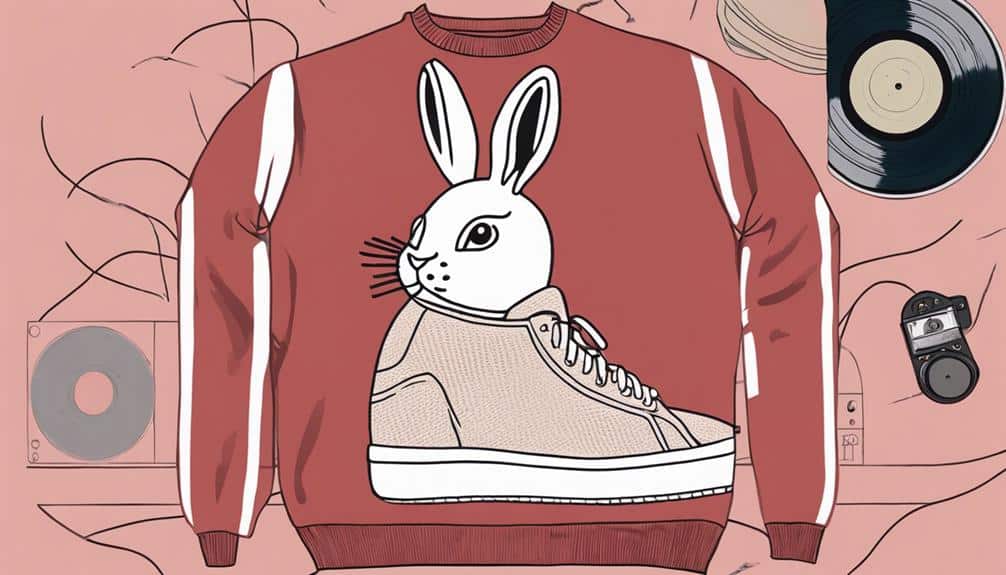
Bunny symbolism in music and fashion resonates deeply with a playful and whimsical aesthetic that appeals to a trendy and youthful audience. Artists like Ariana Grande have embraced bunny imagery in their music videos and merchandise, tapping into the symbolism associated with the Year of the Rabbit. Fashion designers such as Marc Jacobs and Kate Spade have also hopped on the trend, incorporating bunny motifs into their collections to reflect the current pop culture fascination with these furry creatures.
| Music | Fashion |
|---|---|
| Ariana Grande's use of bunny imagery in music videos and merch | Marc Jacobs and Kate Spade incorporating bunny motifs |
| Bunny symbol associated with playfulness and femininity | Reflects trend in pop culture |
| Appealing to youthful audience | Showcasing whimsical aesthetic |
| Embracing innocence | Trend embraced by popular culture |
| Year of the Rabbit symbolism | Trendy and lighthearted aesthetic |
Frequently Asked Questions
What Do Rabbits Symbolize in Different Cultures?
Rabbits symbolize luck, fertility, abundance, and new beginnings in various cultures. They embody themes of rebirth, humility, intuition, and transformation. Their symbolism reflects qualities like kindness, compassion, playfulness, and curiosity across different societies.
What Does a Bunny Symbolize?
Bunny folklore embodies luck, fertility, and transformation. In various cultures, bunnies symbolize new beginnings and abundance. Their representation in literature and media reflects curiosity, intelligence, and playfulness. Rabbit symbolism in dreams often mirrors themes of freedom and contentment.
What Do Rabbits Symbolize in Movies?
In movies, rabbits symbolize various themes. Film analysis reveals their role in representing innocence, duality, and confronting darkness within individuals. Their presence adds depth to narratives, exploring complex human emotions and societal commentaries.
What Do Bunnies Symbolize in Literature?
In literature, bunny symbolism embodies curiosity, intelligence, and new beginnings. These creatures represent playfulness, mischief, and grace, adding depth to narratives. They symbolize cleverness, resourcefulness, and strong bonds, captivating readers with their human-like qualities and wisdom.
Conclusion
To sum up, bunny symbolism in pop culture is a fascinating and versatile theme that has captured the imagination of audiences for centuries. From ancient civilizations to modern media, rabbits have been used to represent a wide range of emotions and concepts, from innocence to horror.
Their presence in literature, film, music, and fashion adds depth and complexity to storytelling, making them a timeless and intriguing symbol that continues to evoke curiosity and fascination in audiences today.

